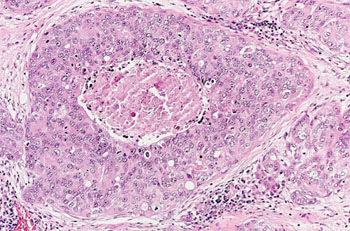Four New Genes Added to Inherited Breast Cancer Risk List
By LabMedica International staff writers
Posted on 17 Jun 2014
Based on risk and frequency, three classes of breast cancer susceptibility genes or loci are currently recognized, but four more genes have been added the growing list of higher risk genes. Posted on 17 Jun 2014
Before a cell becomes cancerous, a number of mistakes need to be present in its genetic code and these mistakes are referred to as mutations. It is possible to be born with a gene mutation that may increase the risk of cancer, this mutation does not mean the individual will categorically suffer from a form of cancer, but the individual will be more likely to develop cancer than the average person.

Image: Histopathology of mammary tissue, high grade breast cancer (Photo courtesy of Johns Hopkins Medicine).
A team of scientists at Huntsman Cancer Institute at the University of Utah (Salt Lake City, UT, USA) who led an international consortium between 1995 and 2005 recruited 1,313 subjects all who were diagnosed with breast cancer at or before age 45 years. The 1,123 controls were frequency matched to the cases within each center on racial/ethnic group, with age at selection not more than ±10 years from the age range at diagnosis of the cases gathered from the same center.
The scientists used high resolution melt curve analysis followed by Sanger sequencing, and they screened for mutation in the coding exons and proximal splice junction regions of the meiotic recombination 11 homolog A (MRE11A)-RAD50 homolog (RAD50) –Nibrin (NBN) gene complex (MRN) in both populations. Rare variants in the three genes were pooled using bioinformatics methods similar to those previously applied to known breast cancer risk and then assessed the results by logistic regression. These three genes MRE11A, RAD50 and NBN were therefore shown to be intermediate-risk breast cancer susceptibility genes.
Sean Tavtigian, PhD, the lead author of the study said, “The breast cancer genes BRCA1 and BRCA2 aren't the whole story when it comes to inherited breast cancer risk. We've known for a long time that more genes had to be responsible, and several have since been discovered, by us and others. Originally, the gene we are currently studying, called RAD50 Interactor 1 (RINT1), was not considered a human cancer susceptibility gene. But then we discovered there was a two- to three-fold increase in risk for breast cancer in families that carry a mutation in that gene." The main study was published on June 3, 2014, in the journal Breast Cancer Research.
Related Links:
Huntsman Cancer Institute













